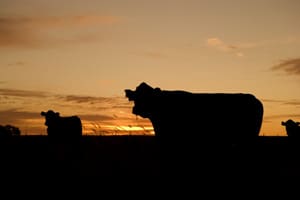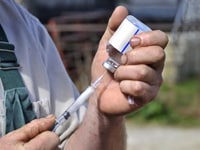 Dr. Gus Brihn is a Veterinary Public Health and Preventive Medicine Resident with the Center for Animal Health and Food Safety at the University of Minnesota. Dr. Brihn is part of our UMASH team with the Promoting Worker Health and Safety for Immigrant Dairy Workers project and has been instrumental in providing insights of the veterinarian’s role on dairy farms in the Upper Midwest.
Dr. Gus Brihn is a Veterinary Public Health and Preventive Medicine Resident with the Center for Animal Health and Food Safety at the University of Minnesota. Dr. Brihn is part of our UMASH team with the Promoting Worker Health and Safety for Immigrant Dairy Workers project and has been instrumental in providing insights of the veterinarian’s role on dairy farms in the Upper Midwest.
In his current capacity as a Veterinary Public Health and Preventative Medicine Resident, Dr. Brihn shares information through the Center for Animal Health and Food Safety (CAHFS) Weekly News. In December 2019 he addressed the American dairy farm in two parts – the changes affecting the industry including the demographics of the workforce and secondly the strength veterinarians offer in educating dairy farmers on health and safety topics for cows, calfs and themselves as producers.
UMASH is committed to the health and safety of dairy farms and workers.
Learn more about our free safety training for dairy farms with Spanish speaking workers by contacting Chela at vazquezc@umn.edu or 612-625-4578
- PART 1:
IN DEPTH: The American Dairy Farm
Immigrant workers make up a little more than half of the workforce on dairy farms in the U.S. In addition, they often receive little on the job training and almost no health and safety training
- PART 2:
EDITORIAL: A New Role for Veterinarians
Veterinarians, with their broad understanding of One Health principals, are key to promoting worker health and safety as it pertains to human-animal interaction.
IN DEPTH: The American Dairy Farm
Gus Brihn, BVMS, MRCVS
Veterinary Public Health and Preventive Medicine Resident
Immigrant workers make up a little more than half of the workforce on dairy farms in the U.S. In addition, they often receive little on the job training and almost no health and safety training
U.S. Dairy Demographics
 Dairy farms in the US have recently received an increasing amount of media attention such as reports of economic pressures causing families to sell off their herds or farms, health and safety incidents including deaths, and their reliance on non-documented workers. Major trends in U.S. milk production currently demonstrate a consistent decline in the number of dairy operations matched by a continual rise in the number of dairy cows per operations. Most milk in the U.S. is produced largely by individuals or families of which many belong to producer-owned cooperatives.
Dairy farms in the US have recently received an increasing amount of media attention such as reports of economic pressures causing families to sell off their herds or farms, health and safety incidents including deaths, and their reliance on non-documented workers. Major trends in U.S. milk production currently demonstrate a consistent decline in the number of dairy operations matched by a continual rise in the number of dairy cows per operations. Most milk in the U.S. is produced largely by individuals or families of which many belong to producer-owned cooperatives.
These cooperatives assemble members’ milk and then move it to processors or manufacturers.
An important factor in this pie is to consider the dairy workforce demographics. Immigrant workers make up a little more than half of the workforce on dairy farms in the U.S. Their demographics are largely young Hispanic males with limited English proficiency and lacking formal education. In addition, they often receive little on the job training and almost no health and safety training as the economic cost of running dairy farms often leaves producers with relatively tight margins for activities such as training and education, leaving workers particularly vulnerable to injuries on the farm.
According to data reported by the National Farmers Union, the average dairy farm has shown a positive net income only once in the last decade, in 2014. Although the overall demand for dairy products has increased in recent years, the projected 13 percent increase in price compared to other years still falls below the average total cost of production for farmers in most of the country. Farmers are struggling. In Wisconsin alone, the USDA estimated that 2,500 dairy farms have gone out of business since 2015.
USDA
National Dairy Farm
American Journal of Industrial Medicine
Dairy Herd Management
The Workforce
 As the nation’s political focus aims at the southern border and the current administration uses rhetoric such as “crisis” when talking about illegal immigration, people forget the vital roles immigrant workers play in the U.S. economy, often in jobs less sought after by the U.S. american workforce. The precarious status of these workers poses serious concerns for the economic viability of the dairy industry. It is estimated that if federal labor and immigration policies reduced the number of foreign-born workers by 50 percent, more than 3,500 dairy farms would close, leading to a large drop in milk production and a spike of about 30 percent in prices. A total elimination of immigrant labor would increase milk prices by an estimated 90 percent.
As the nation’s political focus aims at the southern border and the current administration uses rhetoric such as “crisis” when talking about illegal immigration, people forget the vital roles immigrant workers play in the U.S. economy, often in jobs less sought after by the U.S. american workforce. The precarious status of these workers poses serious concerns for the economic viability of the dairy industry. It is estimated that if federal labor and immigration policies reduced the number of foreign-born workers by 50 percent, more than 3,500 dairy farms would close, leading to a large drop in milk production and a spike of about 30 percent in prices. A total elimination of immigrant labor would increase milk prices by an estimated 90 percent.
So why doesn’t the U.S. american workforce want to fill these positions? In a 2017 study by Cornell Farmworker Program, 30 New York dairy Farms said that they turn to undocumented workers because they are unable to find and keep reliable U.S. citizens to do the jobs. This is, in part, because the jobs are very physically demanding, dirty, and socially denigrated work. Also, it is one of the most dangerous occupations in the U.S. and the 2nd leading cause of workers’ compensation indemnity claims among livestock workers.
However, for workers and farmers, fear of deportation weighs heavy. Immigration and Customs Enforcement (ICE) have raided dairy farms and there are questions about the violation of the rights of farmers and workers as farmers claim raids are occurring without warrants in the pursuit of undocumented workers. These fears also lead to mental health distress and health inequities as workers fear deportation.
CBS news
TAMU
Cornell Farmworker Program
NYT
Legal status and working conditions
Currently in the U.S. there is no visa program for year-round workers on dairy farms. Some farmers are trying to get around this by hiring professionals from Mexico to fill “highly-skilled” jobs on dairy farms. As the struggle to find low-cost workers, a special visa program, called TN NAFTA Professionals, has been used to lure Mexican Veterinarians and engineers with the offers of high-skilled jobs, but then assigning them to clean barns and other menial tasks.
The TN visa, unlike some other visas, does not require businesses to first try and recruit Americans. The idea behind the visa was to allow skilled workers to move quickly and freely between Mexico, the U.S., and Canada to address labor shortages. By bending the rules of the visa program, farms are able to fill menial farm jobs legally with highly-skilled professionals alluring them with the attraction of being hired as an “animal scientist” or “breeder.” What makes things even more difficult is the lack of oversight by the Department of Labor. For employment-based visas, the Department of Labor is required to vet the job offers and make sure the work is appropriate and that the business is not trying to drive down wages. For those on agricultural seasonal worker visas, states are required to inspect employer-provided housing. However, for the TN visa program, none of this is required.
This also reflects the wages workers are receiving under the TN visa program. U.S. consular officers should be verifying the proposed salaries tied to the visas and making sure they reflect salaries that are indicative to that professional level of employment; however, time and again State Department officials approved visas for animal scientists that were 25 to 50 percent less than the prevailing entry-level wage for that position. Some workers are speaking out and reaching confidential settlements. However, rarely is legal action pursued and workers usually stay on the job or leave without turning to courts.
Milwaukee Journal Sentinel
Read the second article in this series: The American Dairy Part II – A New Role for Veterinarians
EDITORIAL: The American Dairy Part II – A New Role for Veterinarians
Gus Brihn, BVMS, MRCVS
Veterinary Public Health and Preventive Medicine Resident
Veterinarians, with their broad understanding of One Health principals, are key to promoting worker health and safety as it pertains to human-animal interaction.
Health and Safety Struggles
Working on a dairy farm is no walk in the park. The idyllic backdrops of the cows grazing on rolling pastures, as the HappyCow advertisement depicts, conveniently leaves out the tough images of the farmers, producers, and dairy workers that work tirelessly to produce that great milk from happy cows. Although this is not a critique on the advertisement, it does highlight an issue that is becoming discussed more and more in today’s media; that is, what is the reality of the U.S. dairy industry.
Although it may not be known or appreciated by the general public, working in the dairy industry is a dangerous profession. Consumer attention often is focused on issues of animal welfare; however, the working conditions and workers’ health and safety is often overlooked. Working in the dairy industry is known to have inherent risks, however dairy-related claims are one of the leading causes of workers’ compensation indemnity claims among livestock workers. The majority of these nonfatal worker injuries on dairy farms are related to animal handling with cattle, often resulting in job restrictions.
As discussed in last week’s Weekly Topic, it is important to understand the workers demographics on dairy farms in the US. Immigrant workers make up half of the workforce on dairy farms in the Upper Midwest. Their demographics are largely young Hispanic males with limited English proficiency and lacking formal education. In addition, they often receive little on the job training and almost no health and safety training as the economic cost of running dairy farms often leaves producers with relatively tight margins for activities such as training and education leaving workers particularly vulnerable to injuries on the farm.
Veterinarians’ Strengths
Veterinarians are viewed by farmers as an important source of information regarding disease control, promoting animal health, and improving economic productivity. This places veterinarians in a unique position to therefore have an influence on the health and safety of the farms they visit. As the experts in topics related to animal handling, welfare, and zoonotic diseases, we can transition these expertise to have direct implications on the health and safety of dairy workers.
Let’s consider our training for a moment. The World Animal Health Organization (OIE) provides a list of competencies for graduating veterinarians (Day-1 competencies) in order to ensure the highest quality of veterinary services globally. Importantly, these competencies not only highlight an understanding of the health of our patients but also demonstrate a responsibility towards human and public health.
We don’t even have to go as far as an intergovernmental organisation (IGO) to see the importance of veterinarian’s role in human and public health, but can also see it reflected in the Association of American Veterinary Medical Colleges (AAVMC) Competency-Based Veterinary education. The AAVMC working group acknowledge that an understanding of the health and safety of people and the environment, recognition of zoonotic disease and responding accordingly including the education of owners, and advising stakeholders on practices that promote animal welfare including recognizing proper handling and/or adequate production facilities are cornerstones to our profession. So as a veterinarian where do we go from here?
OIE: Veterinary Education
AAVMC: Competency Framework
Healthcare Team Member
 Veterinarians, with their broad understanding of One Health principals, are key to promoting worker health and safety as it pertains to human-animal interaction. It is important that veterinarians engage as a member of the health and safety care team on dairy farms as we are considered experts in these areas on human-animal interaction.
Veterinarians, with their broad understanding of One Health principals, are key to promoting worker health and safety as it pertains to human-animal interaction. It is important that veterinarians engage as a member of the health and safety care team on dairy farms as we are considered experts in these areas on human-animal interaction.
If we consider the traditional roles of the veterinarian on dairy farms, we recognise that vets have influence at many key points in health and safety. Importantly, the vet is able to recognize areas for improvement or education, such as the use of appropriate and safe animal handling techniques or understanding the value of general hygiene and herd biosecurity (e.g. infection control). These are common areas that can lead to worker injuries through poor animal handling techniques, improper practices in handling vaccines or biologics (i.e. needlestick injuries) and zoonotic diseases through inappropriate personal protective equipment (PPE) or hygiene.
As veterinarians, we should not shy away from these roles involving worker health and safety, and recognize not only our professional role but also the new avenues of potential business growth through the creation and incorporation of a health and safety plans and education into our regular herd visits. Veterinarians are able to educate the dairy worker staff, managers and owners on proper care and handling of animals as an active member involved in the routine workings of the dairy.
Not only does this have implication on worker health and safety but also animal production, as human factors such as rough handling or improper management techniques can adversely affect cow productivity. As it is well known that working on dairy farms carries inherent risks of potential injury, we should no longer take a side role to prevent it. It’s our job to start thinking outside the box about how to reduce those risks and therefore help protect a valuable sector in our industry.
